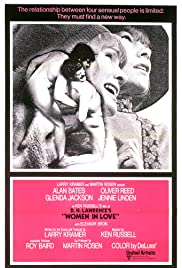
WOMEN IN LOVE
UK, 1969, 130 minutes, Colour.
Alan Bates, Oliver Reed, Glenda Jackson, Jennie Linden, Eleanor Bron, Christopher Gable.
Directed by Ken Russell.
Women in Love is the first film version of one of D.H. Lawrence's major novels since the 1960 version of Sons and Lovers by Jack Cardiff. In fact, it would be profitable to see Sons and Lovers before this film as it would raise many of Lawrence's ideas in a setting which is strongly autobiographical.
It might also be better to see Christopher Miles' version of The Virgin and the Gypsy before Women in Love, as it presents the same types of character and some of the principal issues in much more accessible form.
Women in Love re-creates its period well and is often visually beautiful. It shows the emancipated women of the twentieth century and their yearning and initiatives for fulfilment. It shows the men they love and the questions of masculine loving and sexuality: the all-absorbing love of man and woman and yet the strong need for friendship amongst men. The film is questioning and often puzzling, especially in the yearnings of Gudrun. The film ends with the puzzled face of Ursula wondering about Rupert's statements about love.
Ken Russell is not everybody's director - many find him too flamboyant, sensational and too daring in his presentation of eroticism and nudity. His films of The Music Lovers and The Devils received extreme criticisms and praises.
Alan Bates is good as Rupert but Oliver Reed comes through more strikingly as Gerald. Jennie Linden is Ursula and Eleanor Bron makes an impressive short appearance. But it is Glenda Jackson who makes impact as the seemingly insatiable and complex Gudrun, an Oscar-winning performance. A stage actress from the Royal Shakespeare Company, she appeared in their Marat/Sade and in Negatives, The Music Lovers and Sunday, Bloody Sunday. She became well known to T.V. viewers in the title role of Elizabeth R, a role she repeated in Mary, Queen of Scots. Women in Love raises the Lawrence questions.
1. Do you think that this film gave you a satisfying visual impression of D.H. Lawrence's world? Do you think it gave you insights into his ideas and vision of life? What did it communicate?
2. What kind of girls were Ursula and Gudrun? - flappers 20's style, ambitious, looking forward to marriage, teachers, strong characters, but of a lower class than the Victorian rich? How did each depend on the other?
3. Rupert Birkin is said to stand for Lawrence himself in many ways. What kind of man was he? Common-sensed, passionate, alive and alert, teacher, searching - comment on hie talk about the insect and the figs. What drew him in friendship to Gerald?
4. Gerald Crick comes to the fore in the film move than Rupert - why? What kind of man was he? - aristocratic, rich and boorish, animal-like, sense of guilt about his father, his mother insane, aold, harsh, unloving, afraid, a womaniser, brutal?
5. What did the four principal characters stand, for as persons?
6. Did the physical presence of the countryside in which the characters lived come to the fore - town, countryside, estate?
7. Why was so much attention given to the soirée with its bizarre Russian dance?
8. What was the significance of the wedding, the swim and the entwined dead bodies in the mud?
9. Most would say that the love scenes were sufficiently 'Laurentian'? How necessary were they for this film? How tastefully were they filmed?
10. Why did Birkin tear his clothes off to be in contact with nature?
11. What did the wrestling match represent of the close friendship between Rupert and Gerald?
12. What impact did the death of Gerald's father have on the film?
13. How effective was Gudrun as a tutor?
14. Why did Gerald come to her when he felt in need? Was this passion love for either of them? Was it anything more than self-pity on Gerald's part?
15. How did this consummation contrast with that between Rupert and Ursula? Did they really love each other? (The screenplay of The Virgin and the Gypsy makes the distinction between 'desire' and 'appetite'. Is this relevant here?)
16. Why did they go to Switzerland for their holiday? What did they hope to achieve? What effect did it have on Ursula and Rupert? Did they remain as they were in England?
17. What happened to Gudrun - what more did she yearn for? Why was she attracted to the artist? Did she ever love Gerald? She wanted to be free, sensual, exuberant. Did she achieve this?
18. What disillusioned Gerald? Why did he die? How moving was this?
19. Lawrence tried to explore the love between man and woman and the love between men. The film concludes with Ursula and Rupert discussing. Ursula is puzzled. Rupert explains that for him she is all Women and absorbs all this kind of love from him, but that there is more, a sublimated intense fulfilment of companionship between men. This is what he felt for Gerald. What does this mean?